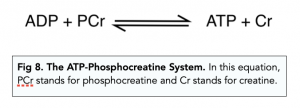Sources of ATP During Contraction (A-level Biology)
Sources of ATP During Contraction
Energy Supply for Muscle Contraction
- Huge amounts of ATP are needed for muscle contraction.
- When oxygen is abundant, ATP is produced mainly by aerobic respiration in the mitochondria. The supply of oxygen to muscle is enhanced by a protein called myoglobin. Myoglobin binds to oxygen in similar way to haemoglobin.
- For highly active muscles and long periods of high-intensity exercise, aerobic respiration does not produce sufficient quantities of ATP.
ATP-Phosphocreatine System
- When oxygen is scarce, the cell relies on its phosphocreatine store to produce ATP in the sarcoplasm.
- This is known as the ATP-phosphocreatine system, an anaerobic process where a phosphate group is added to ADP to maintain ATP levels:

- This can continue until all the phosphocreatine in the cell has been used up. This only takes a few seconds, so the process is best used for short, intense bursts of exercise.
- The hydrolysis is reversible, so the phosphocreatine stores can be re-built when oxygen become available.
Anaerobic Respiration
- After phosphocreatine stores have run out, the cell uses ATP made by glycolysis – an anaerobic process.
- The end product is lactate, which builds up and causes muscle fatigue.
ATP during contraction in A-Level Biology refers to the role of adenosine triphosphate (ATP) in providing energy for muscle contractions. ATP is a molecule that provides energy for many cellular processes, including muscle contractions.
ATP is important for muscle contractions in A-Level Biology because it provides the energy needed for the movement of muscle fibers. When ATP is broken down, it releases energy, which is used to power the movement of muscle fibers.
The sources of ATP during muscle contraction in A-Level Biology include cellular respiration, the breakdown of glycogen stored in the muscle fibers, and the phosphocreatine system.
Cellular respiration provides ATP during muscle contraction in A-Level Biology by breaking down glucose and other organic molecules to release energy. This energy is then used to produce ATP, which can be used to power muscle contractions.
The breakdown of glycogen provides ATP during muscle contraction in A-Level Biology by breaking down glycogen stored in the muscle fibers into glucose, which is then converted into ATP. This ATP can then be used to power muscle contractions.
The phosphocreatine system provides ATP during muscle contraction in A-Level Biology by donating a phosphate group to ADP to produce ATP. This system provides a quick source of ATP for high-intensity activities, such as weightlifting or sprinting.





Still got a question? Leave a comment
Leave a comment